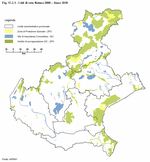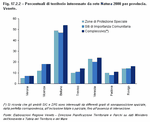(Note 1) In response to the growing need to protect biodiversity, the European Union, and consequently all the Member States as well, developed the Nature 2000 Network project. Starting in the 1970s, the EU's environmental policies worked on developing a new concept of nature as a resource for overall wellbeing aimed at fighting the decrease in biodiversity. Indeed, the loss of biodiversity does not only produce negative effects from an intrinsic point of view, such as an irreversible process of extinction, but also leads to the gradual impoverishment of natural ecosystems and the wealth they produce, given the importance they play in many sectors. For example, there are as many instances of this in the fields of energy and food production as there are in the field of defending soil quality, as all of these factors are related, to varying degrees, to human activity. Therefore, it is impossible to pursue the conservation or restoration of ecosystems without taking into account the needs of the people who live there. These considerations form the basis for the strategy to develop and manage the European ecology network called Nature 2000. In compliance with Directive 92/43/EEC, called "Habitat"
(Note 2), the aim of the network is to focus efforts on the areas that have the greatest wealth in terms of habitat and species. The network is made up of two different types of protected areas: Special Areas of Conservation (SACs), with regards to the "Habitat" Directive, and Special Protection Areas (SPAs), with regards to the "Birds" Directive; these two areas may overlap completely, partially or not at all. Currently, the process of identifying the Special Areas of Conservation is not yet complete so the sites are called European Protected Areas (EPAs)
(Table 17.2.1).
Nature 2000 is developing and strengthening a system of areas which, although they are not contiguous, guarantee the conservation of the ecological functions of habitats and species within various bio-geographical regions, i.e. areas that share historical-biological, geographical, geological, climatic and biotic factors that condition the geographical distribution of living beings. Nature 2000 differs from the concept of protected parks and natural areas in that it places value not only on areas of great natural value, but on the surrounding areas as well. In Italy, the legislative measure that responded to the "Habitat" Directive was Presidential Decree DPR no. 357 in 1997, which was subsequently modified and integrated with a new Presidential Decree DPR no. 120 in 2003. These measures directly assign the regions the task of setting up and carrying out the Nature 2000 project within their own territories with regards both to assigning areas to become Nature 2000 sites and to managing these sites using the necessary tools and policies that will help prevent the deterioration of natural habitats, the habitats of species and the threat to certain species. To date, in the Veneto region, the process carried out to be in compliance with the Nature 2000 network has been long and very articulate. The first step was to develop a detailed list of possible sites following an initial census as part of the Biotaly programme, which ended in 1998 and was coordinated by the Ministry of the Environment in collaboration with scientists from the Italian Botanical Society, the Italian Zoological Union and the Italian Society of Ecology. In 2004, the regional administration revised the borders of the sites in order to be more consistent with the network regarding species that are still very threatened. Then, in 2006, further changes were made to the borders and standards to be maintained in some sites based on recent scientific contributions that provided new indications regarding the presence and state of conservation of certain habitats and species. In 2007, additional changes were made following proposals made by some local administrations to integrate the list with additional sites that proved to be important in compliance with the directives. Finally, in December 2008, the Regional Council made final changes to the list in response to specific compensatory measures that called for an extension of the borders of some of the existing sites. Today the Nature 2000 Network is made up of 128 sites, spread out over more than one-fifth of the region covering a total of almost 414,675 hectares
(Figure 17.2.1).
The 67 Special Protection Areas and the 102 European Protection Areas overlap to varying degrees, but cover an equal surface area of the regional network, i.e. about 20% (a little less than 360,000 hectares for the former and a little less than 370,000 for the latter). Within these sites, there are a total of 76 habitats of European importance reported in Appendix I of the "Habitat" Directive and more than 850 species of flora and fauna, 284 of which are included in the appendices to the "Habitat" and "Birds" Directives. These numbers demonstrate both the wealth of the natural patrimony in the region, as well as an indirect estimate of the problems associated with management strategies, i.e. the network does not have homogenous characteristics and the geographical distribution of its sites is very irregular. Furthermore, there are significant differences in the physical, environmental and biological characteristics of the sites in that the boundaries of the sites range from just a few hectares to several tens of thousands of hectares. Overall the Special Protection Areas and the European Protection Areas in the Veneto region cover, even though only partially, over 60% of the municipalities in the region. It is important to point out that, in compliance with the Law 394/91, all of the Protected Natural Areas in the region, i.e. State and Regional Parks and Reserves, are included in the Natura 2000 sites. This makes it possible to integrate existing protection and management tools with those indicated by Community Directives in order to improve the interconnection between the areas and their relative ecological function
(Figure 17.2.2).







